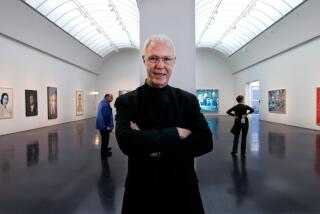HIGH HOPES AMID LOW FINANCING : SCHOOL ARTS ACTIVISTS SHOW SPIRIT
Although the fiscal picture for arts education in California’s public schools remains bleak, the mood of arts specialists at a conference on Tuesday in Irvine was hopeful and at times combative.
The 60 representatives of public agencies, school districts and private organizations sounded the themes usually heard at such conferences--a call for accelerated lobbying in Sacramento and much praise for pilot projects attempting to integrate the arts into the basic curriculum.
Moreover, speakers at Tuesday’s California Alliance for Arts Education conference at the Irvine Fine Arts Center claimed that arts activism has never been more spirited, despite the “minimal funding” in most public school arts programs.
“Ten years ago, there wasn’t much going on. But today--and you can sense it at this conference--there is so much energy, so many new ideas,” said Frances Hine, associate director of the Getty Center for Education in the Arts, which backs projects in 21 Los Angeles County districts.
The turnout at Tuesday’s conference was smaller than expected, but organizers said the 60 participants represented most of the Southern California region, from Ventura to San Diego. The third meeting in this series sponsored by the California Alliance for Arts Education will be held Tuesday in San Jose (the first was Jan. 28 in Sacramento).
“This is the first time the Alliance has sponsored this kind of regional-level conferences in Southern California. That in itself is another example of the greater communication among arts advocates,” said Rosemarie Glover, consultant for the Los Angeles County superintendent of schools office.
(The California Alliance for Arts Education also is co-sponsoring Orange County’s first “Imagination Celebration,” a two-week arts education festival that starts Saturday. The Alliance is an affiliate of a national arts education program headed by the John F. Kennedy Center for the Performing Arts in Washington.)
Glover and other conference speakers duly noted the massive cuts in arts education programs since the late 1970s by most of the financially beleaguered school districts in California.
Statewide, one of the most dramatic results was the drop in the number of district-level coordinators in music or fine arts from 400 to 80 in five years. (Los Angeles County now has about 18 district coordinators; Orange County, about 13.)
At the same time, conference speakers claimed, arts educators have won acceptance of the arts as a “curriculum basic” from increasing numbers of community groups and non-arts teachers. The premise, they said, is that courses in the performing, visual and media arts are equal to--and an enhancement of--traditional school basics.
This kind of acceptance, speakers argued, has been demonstrated by the results of 35 pilot projects financed under a program run by the state Department of Education and California Arts Council.
Although state funds for the Exemplary Arts Education Program ended in 1983-84, at least 10 of the projects continue to operate under local district and/or private community financing, said Louis Nash, a California Alliance officer and a former Department of Education consultant.
“These projects haven’t just survived since the state pulled out. They have actually grown, and they tell us something of each community’s depth of commitment in the arts,” said Nash.
One of these “survivors”--the Inter-Disciplinary Education Through the Arts and Language or Ideal consortium in Orange County--was held up as a model at the Alliance conference.
Started in 1981-82 at the elementary levels with five districts (Anaheim City, Garden Grove Unified, Placentia Unified, Santa Ana Unified and Westminster), the Ideal program brought more arts teachers, visits by artists and other arts encounters to the classroom and provided more intensive teacher training in the arts. Also, the Ideal program was seen as a way to reinforce learning in such subjects as English, mathematics and science.
When state support ended in mid-1984 (the program received $140,000 over three years), Ideal continued, backed wholly by funds from the participating districts and a newly formed parents’ organization.
“We’ve been able to go on with the consortium at pretty much the same level and with an even more cohesive network,” said Winifred Gregg, Ideal coordinator. This year, $30,000 comes from seven districts and $20,000 from the Project Ideal Foundation. More than 6,000 elementary children and 200 teachers, administrators and aides are in the program.
Other “survivor” projects include those in Chula Vista, Fresno, Glendale, La Mesa, Los Angeles, Palo Alto, Sacramento and Santa Cruz, according to Nash.
While conference speakers said arts advocacy is stronger than ever, they also maintained that such activism needs to be more relentless--and directed.
“You can’t just go around praising the arts to the skies. Anyone can do that,” said Frank Summers, a state Department of Education consultant. “No, you have to be willing to become more political. You have to be willing to argue your cause again and again, and to the people who can do something about it.”
One advocacy argument, said conference speakers, is clearly related to such new complexes as the Orange County Performing Arts Center, set to open this fall in Costa Mesa.
“It’s really quite simple, when you get down to it,” said Jim Burk, consultant for the Los Angeles City Unified School District. “What our programs are doing is the educating of people who will be tomorrow’s (arts) audiences.”
More to Read
The biggest entertainment stories
Get our big stories about Hollywood, film, television, music, arts, culture and more right in your inbox as soon as they publish.
You may occasionally receive promotional content from the Los Angeles Times.










